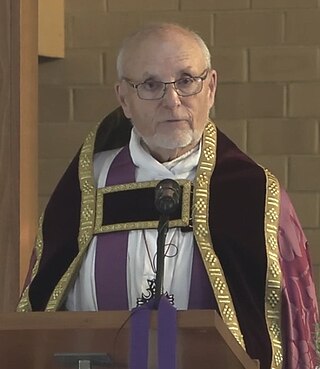
The Church of Ireland is a Christian church in Ireland, and an autonomous province of the Anglican Communion. It is organised on an all-Ireland basis and is the second-largest Christian church on the island after the Roman Catholic Church. Like other Anglican churches, it has retained elements of pre-Reformation practice, notably its episcopal polity, while rejecting the primacy of the pope.

Christ Church Cathedral, more formally The Cathedral of the Holy Trinity, is the cathedral of the United Dioceses of Dublin and Glendalough and the cathedral of the ecclesiastical province of the United Provinces of Dublin and Cashel in the (Anglican) Church of Ireland. It is situated in Dublin, Ireland, and is the elder of the capital city's two medieval cathedrals, the other being St Patrick's Cathedral.
Since the 1990s, the Anglican Communion has struggled with controversy regarding homosexuality in the church. In 1998, the 13th Lambeth Conference of Anglican bishops passed a resolution "rejecting homosexual practice as incompatible with Scripture". However, this is not legally binding. "Like all Lambeth Conference resolutions, it is not legally binding on all provinces of the Communion, including the Church of England, though it commends an essential and persuasive view of the attitude of the Communion." "Anglican national churches in Brazil, South Africa, South India, New Zealand and Canada have taken steps toward approving and celebrating same-sex relationships amid strong resistance among other national churches within the 80 million-member global body. The Episcopal Church in the U.S. has allowed same-sex marriage since 2015, and the Scottish Episcopal Church has allowed same-sex marriage since 2017." In 2017, clergy within the Church of England indicated their inclination towards supporting same-sex marriage by dismissing a bishops' report that explicitly asserted the exclusivity of church weddings to unions between a man and a woman. At General Synod in 2019, the Church of England announced that same-gender couples may remain recognised as married after one spouse experiences a gender transition. In 2023, the Church of England announced that it would authorise "prayers of thanksgiving, dedication and for God's blessing for same-sex couples."

Christ Church Cathedral in Vancouver, British Columbia, Canada, is the cathedral church of the Anglican Diocese of New Westminster of the Anglican Church of Canada, and the second church to have been the diocese's cathedral. A place of worship in Greater Vancouver, the cathedral is located at 690 Burrard Street on the northeast corner of West Georgia Street, directly across from the Fairmont Hotel Vancouver in Downtown Vancouver.

The Anglican Church of Australia, formerly known as the Church of England in Australia and Tasmania, is a Christian church in Australia and an autonomous church of the Anglican Communion. It is the second largest church in Australia after the Catholic Church. According to the 2016 census, 3.1 million Australians identify as Anglicans. As of 2016, the Anglican Church of Australia had more than 3 million nominal members and 437,880 active baptised members. For much of Australian history since the arrival of the First Fleet in January 1788, the church was the largest religious denomination. It remains today one of the largest providers of social welfare services in Australia.

The Anglican Church of Canada is the province of the Anglican Communion in Canada. The official French-language name is l'Église anglicane du Canada. In 2022, the Anglican Church counted 294,931 members on parish rolls in 1,978 congregations, organized into 1,498 parishes. The 2021 Canadian census counted 1,134,315 self-identified Anglicans, making the Anglican Church the third-largest Canadian church after the Catholic Church and the United Church of Canada.

The blessing or wedding of same-sex marriages and same-sex unions is an issue about which leaders of Christian churches are in ongoing disagreement. Traditionally, Christianity teaches that homosexual acts are sinful and that holy matrimony can only exist between two persons of different sexes. These disagreements are primarily centred on the interpretation of various scripture passages related to homosexuality, sacred tradition, and in some churches on varying understandings of homosexuality in terms of psychology, genetics and other scientific data. While numerous church bodies have widely varying practices and teachings, individual Christians of every major tradition are involved in practical (orthopraxy) discussions about how to respond to the issue.
The Anglican Church in Aotearoa, New Zealand and Polynesia, formerly the Church of the Province of New Zealand, is a province of the Anglican Communion serving New Zealand, Fiji, Tonga, Samoa, and the Cook Islands. Since 1992 the church has consisted of three tikanga or cultural streams: Aotearoa, New Zealand, and Polynesia. The church's constitution says that, among other things, it is required to "maintain the right of every person to choose any particular cultural expression of the faith". As a result, the church's General Synod has agreed upon the development of the three-person primacy based on this three tikanga system; it has three primates, each representing a tikanga, who share authority.

St John's Cathedral is the cathedral of the Anglican Diocese of Brisbane and the metropolitan cathedral of the ecclesiastical province of Queensland, Australia. It is dedicated to St John the Evangelist. The cathedral is situated in Ann Street in the Brisbane central business district, and is the successor to an earlier pro-cathedral, which occupied part of the contemporary Queens Gardens on William Street, from 1854 to 1904. The cathedral is the second-oldest Anglican church in Brisbane, predated only by the extant All Saints church on Wickham Terrace (1862). The cathedral is listed on the Queensland Heritage Register.

The Anglican Diocese of Brisbane, also known as Anglican Church Southern Queensland, is based in Brisbane, Queensland, Australia. The diocesan bishop's seat is at St John's Cathedral, Brisbane. The diocese stretches from the south-eastern coastline of Queensland, down to the New South Wales border and west to the Northern Territory and South Australian borders. The diocese currently markets itself as "Anglican Church Southern Queensland" (ACSQ). The "Anglicare Southern Queensland" brand is also heavily promoted by the diocese.

The Anglican Diocese of Bendigo is a diocese of the Anglican Church of Australia. It is situated in the Bendigo region of the state of Victoria, Australia. Its geographic remit extends from that part of Victoria that lies north of the Great Dividing Range and west of the Goulburn River to the border with the state of South Australia. The diocesan cathedral is St Paul's Cathedral, Bendigo. The diocese was separated from the Diocese of Melbourne in 1902, with Henry Archdall Langley installed as the first bishop. The current bishop, Matt Brain, was installed on 17 February 2018.
The Anglican realignment is a movement among some Anglicans to align themselves under new or alternative oversight within or outside the Anglican Communion. This movement is primarily active in parts of the Episcopal Church in the United States and the Anglican Church of Canada. Two of the major events that contributed to the movement were the 2002 decision of the Diocese of New Westminster in Canada to authorise a rite of blessing for same-sex unions, and the nomination of two openly gay priests in 2003 to become bishops. Jeffrey John, an openly gay priest with a long-time partner, was appointed to be the next Bishop of Reading in the Church of England and the General Convention of the Episcopal Church ratified the election of Gene Robinson, an openly gay non-celibate man, as Bishop of New Hampshire. Jeffrey John ultimately declined the appointment due to pressure.

The Cathedral of the Holy Trinity is the cathedral of the Anglican Diocese of Quebec. It is home to two parishes: the Parish of Quebec and la Paroisse de Tous les Saints. It stands on the western side of Quebec City's Place d'Armes.

The Church of St George, Bolton, is a redundant church in Bolton, Greater Manchester, England. It was designated a Grade II* listed building on 26 April 1974. It was completed in 1796 and had a shallow chancel and south chapel added or rebuilt 1907 by James Simpson. It closed in 1975, and is now a crafts centre.

Ralph David Farrer is a retired Anglican bishop. He was formerly the Bishop of Wangaratta in the Anglican Church of Australia and more recently a vicar in the Church of England.

Holy Trinity Church is an Anglican church in the centre of Guildford, England. A large, red brick building, it was built in the early 1760s on the site of a mediaeval church which collapsed in the mid-18th century. It is the only large Georgian church in Surrey, sporting detailed frescos of the Crucifixion surrounded by the Saints and the Ascended Lord in Heaven, as well as one of the largest unsupported ceilings in southern England. It is a Grade I listed building.
The Anglican Church of Canada is the third largest church in Canada, after the Roman Catholic Church and the United Church of Canada. After many years of debate, the first blessing of a same-sex partnership took place in 2003, by the Diocese of New Westminster, in Vancouver. This was not considered a marriage ceremony, but rather a blessing of "permanent and faithful commitments" between persons of the same sex.

Holy Trinity Church, commonly known as Horwich Parish Church, is a Grade II listed building in Horwich, Greater Manchester, England. It is an active Church of England parish church and part of the Deane deanery in the archdeaconry of Bolton, diocese of Manchester. Holy Trinity Church is now part of the United Benefice of Horwich and Rivington, which includes the other two Anglican churches in Horwich, St Catherine's Church and St Elizabeth's Church, and Rivington Anglican Church.

Holy Trinity Parish Church is the parish church of Sutton Coldfield, West Midlands, England. It is Grade I listed and gives its name to the ward in which it stands, Sutton Trinity.
Clarence Edgar Bester is a South African-born Australian bishop in the Anglican Church of Australia. He has served as the 11th Bishop of Wangaratta since February 2020.
















